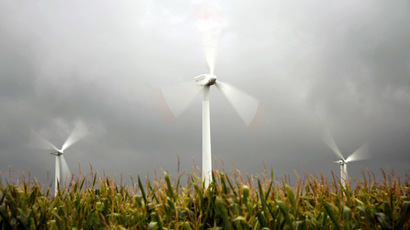Nuke dump proposal near Lake Huron raises alarm in US, Canada

Plans for a nuclear waste facility near the US-Canadian border – less than a mile from one of the world’s largest sources of fresh water – has triggered a public outcry among Americans and Canadians.
A heated debate is surfacing over Ontario Power Generation’s
ambitious plans to burrow 2,200 feet underground near Kincardine,
a small town of just over 11,000 in the province of Ontario,
Canada, to construct a nuclear waste storage facility.
The radioactive waste has been steadily accumulating from
Ontario’s 20 nuclear reactors.
A review panel appointed by the Canadian government will issue a
recommendation in coming weeks to Canada’s Cabinet, which will in
turn decide whether or not to approve the utility’s plan.
Public opposition to the proposal would probably have remained
muted if not for one glaring footnote: The site for the planned
nuclear waste dump is situated less than a mile away from the
sparkling shores of Lake Huron, which, together with Lakes
Superior, Michigan, Erie, and Ontario, comprise the largest group
of freshwater lakes on Earth, with 21 percent of the world's
total supplies.
While tens of millions of American and Canadian residents depend
upon the Great Lakes for their supplies of fresh water, an
increasingly threatened global resource, many others look to the
business opportunities connected to the 94,250 square-mile
(151,000sq km) body of water.
In the US state of Michigan alone, the fishing industry pulls in
$2.4 billion annually, while the tourism industry generates an
estimated $13 billion. Given these factors, it’s no wonder that
the proposed nuclear dump is generating such hostility.
“I’m up in arms,” Michigan resident Sherry Hummel of
Williamsburg, Michigan told the Times Herald. “It’s just a
dangerous, dangerous thing to do near 20 percent of the world’s
[unfrozen surface] fresh water.”
However, Ontario Power Generation (OPG), which plans to bury the
nuclear waste 2,200 feet (670 meters) underground in a layer of
limestone, capped-off with a 660-foot layer of shale, is
confident its proposal poses no risk to the Lake Huron region and
beyond.
While most of the disposed items would be low-level waste, the
underground facility also would handle intermediate-level waste,
“like filters, resins, things that are closer to the nuclear
core,” utility spokesman Neal Kelly told the paper.
“They are much more radioactive and need to be handled with a
lot more care,” he said.

Despite assurances that the facility will pose no risk to the
Great Lake basin, grassroots movements are taking OPG to task
over its plans.
“Ontario Power Generation did not consider any other sites for
the location of this nuclear waste dump,” Beverly Fernandez,
who helped establish Stop the Great Lakes Nuclear Dump, a non-profit
organization, told the Times Herald. “A few thousand people in
the small town of Kincardine are making this decision on behalf
of 40 million people” living in the vicinity of the Great
Lakes.
The organization has collected more than 38,000 online petition
signatures from both Americans and Canadians who want to see the
project canceled.
Meanwhile, Larry Kraemer, mayor of Kincardine, argued in favor of
the underground dump to store nuclear waste, which is presently
stored above ground in warehouses adjacent the Bruce nuclear
plant, for the 500 construction jobs the project is anticipated
to create.
At the same time, Kraemer played down the potential risks of the
nuclear dump, pointing to the decision of his own residents to
continue living in the town.
“These people know nuclear; they know the safety of it, and
they choose to live here,” he told the paper.
Last week, Michigan Senators Debbie Stabenow and Carl Levin sent
a letter to Secretary of State John Kerry requesting the US
government get involved in the controversy.
“The placement of this nuclear waste storage facility is of
great concern given its location near Lake Huron and the
importance of the Great Lakes to tens of millions of US and
Canadian citizens for drinking water, fisheries, tourism,
recreation and other industrial and economic uses,” Democrats
Stabenow and Levin wrote in their letter. “Special
consideration must be given to the potential environmental
impacts of such a large radioactive waste site on the shores of
our region’s most important natural resource…
“We strongly urge you to engage the International Joint
Commission on this important topic and also encourage the
Canadian government to reconsider placing a nuclear waste dump
near the shores of Lake Huron.”
If there are no overriding objections to the project, work on the
facility could begin in 2014.













